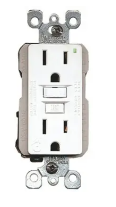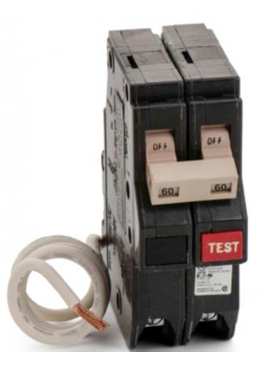September 22, 2023
Basic Electrical Saftey: GFCIs

Ground fault circuit interrupter, also commonly referred to as a GFCI is an important safety device that helps prevent electrocution when we are using electrical tools or equipment near water or in wet environments; but it only works as long as it is properly installed and maintained.
When a tool is plugged into an electrical receptacle, electricity flows from the receptacle to the tool through one of the hot wires in the power cord. When the trigger or switch on the tool is activated, the current then flows through the tool to make it run and then returns to the receptacle, the neutral wire in the power cord. Ideally the same amount of current flows from the receptacle to the tool and then back to the receptacle – unless there is ground fault.
Electrical receptacles and breakers equipped with a GFCI monitor the amount of current flowing through this path, and if it senses a drop in returning current of just a few thousandths of an amp, it almost instantaneously trips an internal breaker and stops power flowing from the receptacle.
Also be aware that if one of the receptacles in a circuit containing multiple receptacles is GFCI protected, the GFCI will protect all the other receptacles wired behind it in the circuit, but not any that are wired in front of it in the circuit.

You can usually distinguish a GFCI receptacle by its two buttons, typically marked “TEST” and “RESET”, placed in the center of the receptacle (see handout). There are also GFCI breaker switches that can be installed inside of a breaker box which protects all receptacles in that circuit. There are also portable GFCI-equipped devices that can be plugged into an unprotected receptacle (see handout for examples of these devices) which protect equipment plugged into them. These breakers and portable devices also have the same two “TEST” and “RESET” buttons as a GFCI receptacle.
Because GFCI devices do occasionally malfunction or wear out over time, it is vitally important that we test them. This is typically done by depressing the “TEST” button on the receptacle or GFCI breaker; you should hear a faint “click” sound as the device trips. You can further confirm the receptacle was de-energized by plugging in a tool such as a drill to the receptacle and trying to operate it by depressing the trigger; it should not run if the GFCI tripped as designed. Once you confirm that a GFCI receptacle or breaker switch is functioning properly, firmly press the “Reset” button to re-energize the receptacle or circuit. And if any GFCI-protected device is not functioning properly, do not use it. Instead, mark it to identify it is not to be used, and then call a qualified electrician so it can be repaired or replaced.